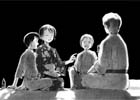Someday’s Dreamers
| Japanese Title: Mahou Tsukai ni Taisetsu na Koto | ||
| Also Known As: Things Important to a Mage, Things Precious to a Mage | ||
| Genre: Drama | ||
| Length: 2 Volumes | ||
| Allegiance: Kadokawa Shoten | ||
| Mangaka: Yamada Norie, Yoshizuki Kumichi | ||
| Vintage: 2005 | ||
| Intelligence Agency Report by: Kuzu Ryu Sen | ||
| Meet Kikuchi Yume, 18 years old, hailing from Tono City, Iwate Prefecture. A country girl through and through, she’s now facing the biggest trial of her life: the megalopolis of Tokyo. Now, one might inquire as to why a girl would be struggling in vain to hide her Tohoku accent while stumbling blindly through the streets of Tokyo, but there’s a simple explanation: Yume, like quite a few other people around the world, is a mage. To add to all this, her mother, Kikuchi Etsuko, is a renowned mage, giving Yume a lot to live up to. But for now, all she can do is search for Oyamada Masami, the person who will guide and supervise her as she strives to become a skilled mage. | ||
|
|
||
| Research Agent Report by: Kuzu Ryu Sen | ||
| Plot Characters Impact Visual |
7.50 7.75 8.50 9.25 |
|
| Overall | 8.25 | |
| (not an average) | ||
| Mahou shoujo is certainly one of the most repetitive and stale genres in anime and manga. The industry seems to spew out the same heroines in short skirts chanting all too familiar magical spells to defeat the same generic villains, with the same furry mascots offering encouragement faster than the Ottawa Senators get dumped out of the playoffs. So one can imagine the surprise and relief that I felt upon discovering Someday’s Dreamers. For once, a manga actually takes a look at the trials and tribulations of acquiring and developingspecial powers, rather than just the process of using them to fight some diabolical evil.
Someday’s Dreamers is really more of a social and cultural commentary than your average fantasy good versus evil narrative. Yume, after all, is just a normal 18 year old girl: timid, shy, but passionate and quite outspoken when provoked. This manga, despite its brevity, does quite a good job of demonstrating the personal growth of this young girl, contrasting her naivety with the maturity of a small but colourful supporting cast. Yet at the same time, what Yume lacks in knowledge, she makes up for in passion and willpower, and serves as an inspiration to her somewhat disillusioned peers. It is the skillful weaving of this codependent relationship that allows Someday’s Dreamers to reach its audience both quickly and effectively. A number of key social issues are presented in Someday’s Dreamers, none more so than that of differences in society. Magic usage and the differences between mages and normal people are used to express views about real world issues such as scientific morality and ethnic tolerance. The fact that the viewer is made to observe the manifestation of these issues through the eyes of a naive innocent 18 year old girl renders the manga much more powerful. The final thing to note here is that the art is well – beautiful. Yoshizuki Kumichi’s illustrations, and particularly his use of a light palette, create a wonderful picture of Yume’s world. There is a gentleness to the art in Someday’s Dreamers that lends it a sort of tranquility. Though short in length, clocking in at a whopping eight chapters and two omake sections, Someday’s Dreamers still manages to provide quite a good read. It relies on socio-cultural issues just enough to provide a basis for conflict and character development without turning into an incessant stream of philosophy. It creates a somewhat charming universe, filled with likeable and non-one-dimensional characters. Heck, it doesn’t even take that long to read. For all those reasons, this is a piece that everyone should read, even though its score is not a perfect ten.
|
||




